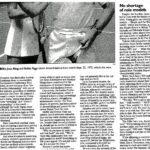The Rise of Women’s Professional Sports
Though professional level sports for women had been around in some capacity for decades, they became more popular in the early 1970s and into the 1990s. In 1991, when the first FIFA Women’s World Cup was held in France, the United States women’s national soccer team won the championship. Just five years later, the addition of women’s soccer at the 1996 Olympics in Atlanta, along with the high number of women participating, earned them the nickname “The Women’s Games.”







The oldest women’s professional sports association in the United States is the Ladies Professional Golf Association, which was founded in 1950. More recently created professional leagues include the Women’s Tennis Association (1973), National Pro Fastpitch (2004), National Women’s Soccer League (2013), and the National Women’s Hockey League (2015). There were several attempts to start a women’s professional basketball league, but it wasn’t until 1996 that the Women’s National Basketball Association that we still have today was formed. Atlanta-based professional teams include the Atlanta Dream, a WNBA team and the Atlanta Harlequins, a professional rugby team.








Even at the professional level, women face discrimination in compensation, resources, facility quality, media coverage, and sponsorships. A lawsuit filed by the United States women’s national soccer team in 2019 exposed the glaring differences in pay and conditions between men and women’s professional teams. Though they were barred by the court from continuing the pay dispute, they were able to reach a settlement on conditions. Despite obstacles like these, women like Serena Williams, Megan Rapinoe, and Simone Biles have become household names, serving as role models for young girls who want to be athletes.
Seeing a woman as that coaching figure, I wanted to coach…In the back of your mind you’re like ‘Hey I can be the first to do something as well.
Kelcey Roegiers, interviewed by Samantha Harvel, March 26, 2021




